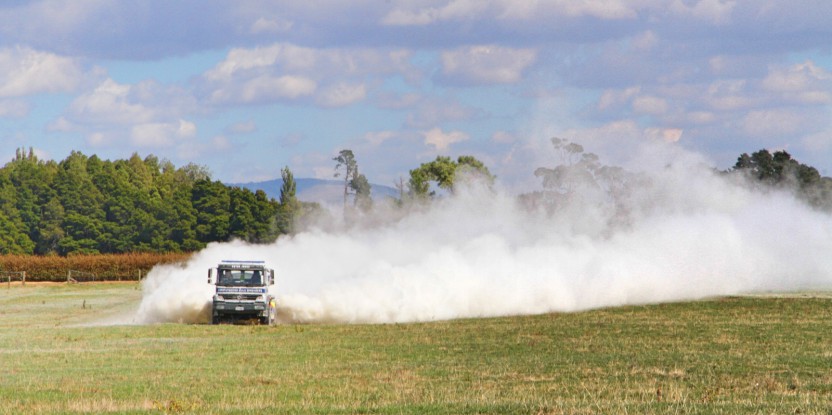
BOGOR, Indonesia—Failure to consider the effects of agriculture spillover into areas adjacent to intensely farmed zones will likely have severe consequences for soil variables a new study reports.
The study, conducted in the Waipa District on the north island of New Zealand, looked at areas representative of “land sparing,” the combination of small isolated forested areas or forest remnants embedded within lands used for food production. These areas—typically two to 16 hectares—represent the only remaining natural habitats in lowland agricultural landscapes.
The authors report that intensive agricultural land use appears to have a major impact on soil properties in these forest areas, apart from any other natural differences that might have occurred among soil types prior to conversion to agriculture. They found that there is a “pervasive” alteration of soil properties in areas where intensive farming occurs, with high levels of nitrogen, phosphorus, uranium, and cadmium found. The authors found that even when forest remnants were fenced off or “spared” for conservation purposes and livestock access prevented, nutrient spillover via runoff and aerial drift of fertilizers caused substantial effects beyond fenced boundaries.
As farming becomes more intensive, this spillover has increased. The spillover—particularly from the nitrogen and phosphorus found in fertilizer—did not just affect the edge of the native forest boundaries, though it is most concentrated in those areas.
“With regards to the land sparing debate, there has been no direct test of the knock on effects or “spillover effects” of intensive farming practices and associated large inputs of fertiliser,” said Liz Deakin, a post-doctoral researcher with the Center for International Forestry Research (CIFOR) and one of the authors of the study. “From a conservation perspective we’ve got the evidence that land sparing does not provide a silver bullet for reconciling production and maintaining forest resilience because the tradeoffs are quite high.”
The idea of intensive farming to grow more food to feed more people without any costs in other areas is just simply not going to work
Those tradeoffs, according to Deakin, include financial consideration for farmers who, as they intensively farm, are losing nitrogen from fertilizers into neighboring remnant forest areas. Fertilizer is expensive. Reducing the spillover of nutrients, by introducing production efficiencies will increase profits and decrease environmental damage.
“This research is a red flag,” Deakin said. “The idea of intensive farming to grow more food to feed more people without any costs in other areas is just simply not going to work. There needs to be a combination of different practices going on, bringing in more sustainable practices.”
A NEW WAY: BUFFER ZONES
Possibilities include the introduction of vegetated buffer zones, and Deakin points out that much work has been done on aquatic buffer zones, to prevent spillover from land to water. Nevertheless, vegetated buffer zones are rare, despite similar principles and the potential to provide other benefits such as reduced microclimatic edge effects on both plant and animal communities.
“Any work that has been done previously on spillover from intensive farming into natural systems has solely been done on aquatic systems. Nowhere in the world has work been done on terrestrial systems, so this is a novel piece of research,” said Deakin, acknowledging that a buffer zone would only be part of pollution mitigation.
While farmers work hard to create benefits from improving yields from their land, that has to be weighed against the increasing scale of livestock and nutrient spillover from farmed areas into adjacent natural habitat.
A failure to take into account how agricultural runoff affects landsurrounding intensive agriculture areas, Deakin warns, may also have substantial impacts on biodiversity and ecosystem service provision.
While increased yields from intensive farming increases revenue and food production, more research is required, Deakin says, to determine what extent the costs to adjacent natural habitats are.
For further information on the topics of this research, please contact Liz Deakin at l.deakin@cgiar.org.
Funding for this study was provided through the Royal Society of New Zealand Marsden grant. CIFOR’s research on the links between forests and agriculture forms part of the CGIAR Research Program on Forests, Trees and Agroforestry.
We want you to share Forests News content, which is licensed under Creative Commons Attribution-NonCommercial-ShareAlike 4.0 International (CC BY-NC-SA 4.0). This means you are free to redistribute our material for non-commercial purposes. All we ask is that you give Forests News appropriate credit and link to the original Forests News content, indicate if changes were made, and distribute your contributions under the same Creative Commons license. You must notify Forests News if you repost, reprint or reuse our materials by contacting forestsnews@cifor-icraf.org.
Further reading
Study: As forests, grasslands gave way to farms, soil carbon emissions soared
Forests ‘not only about the environment’: On SDGs, zero-deforestation pledges
As Climate Change And Poor Habits Parch Central Asia, Can Policy Changes Help?
Peatland Loss Could Emit 2,800 Years’ Worth Of Carbon In An Evolutionary Eyeblink: Study
